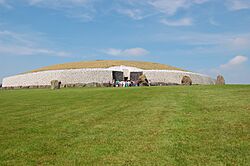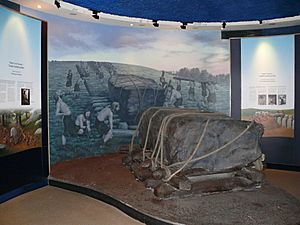Brú na Bóinne facts for kids

Newgrange passage tomb
|
|
| Location | County Meath, Ireland |
|---|---|
| Coordinates | 53°41′34″N 6°26′58″W / 53.69284°N 6.44932°W |
| Type | Archaeological site |
| Area | 780 hectares |
| History | |
| Founded | c. 3300 BC |
| Abandoned | c. 2900 BC |
| Type | Cultural |
| Criteria | i, iii, iv |
| Designated | 1993 (17th session) |
| Part of | Brú na Bóinne - Archaeological Ensemble of the Bend of the Boyne |
| Reference no. | 659 |
Brú na Bóinne (which means "mansion or palace of the Boyne") is an amazing ancient place in County Meath, Ireland. It's located right where the River Boyne makes a big bend. This area is one of the most important Neolithic (New Stone Age) sites in the world.
It has at least ninety ancient monuments. These include huge passage tombs, burial mounds, and standing stones. The most famous tombs are Newgrange, Knowth, and Dowth. People built them around 5,000 years ago, making them older than the Egyptian pyramids!
These tombs are famous for their incredible megalithic art, which is ancient stone carvings. Brú na Bóinne is also special because some tombs line up with the sun during the winter solstice and equinoxes. This shows how smart the ancient builders were.
Ancient Irish stories say these tombs are gateways to another world. They were believed to be homes for gods and goddesses. Since 1993, UNESCO has called Brú na Bóinne a World Heritage Site. This means it's a very important place for everyone on Earth.
Contents
Exploring Brú na Bóinne: Where Is It?
This ancient site is found in County Meath, Ireland. It's about eight kilometers west of a town called Drogheda. The capital city, Dublin, is about 40 kilometers to the north.
The River Boyne wraps around Brú na Bóinne on three sides. Another small river, the Mattock, runs along the northern edge. This means the site is almost completely surrounded by water, like a special island.
What Makes Brú na Bóinne So Special?
People have lived in this area for at least 6,000 years. But the biggest and most impressive buildings were made about 5,000 years ago. This was during the Neolithic period, when people first started farming.
The site is a huge collection of ancient structures. You can find large mounds, chamber tombs, and tall standing stones. There are also other prehistoric enclosures. These were built between 3500 BC and 3200 BC.
The builders of Brú na Bóinne were very clever. They used advanced building skills and knew a lot about science and astronomy. This is clearest in the amazing passage tomb of Newgrange.
The entire area covers about 780 hectares (that's like 1,927 football fields!). It has around 40 passage graves and many other ancient sites. Most of these monuments are on the north side of the river.
The Big Three Tombs: Newgrange, Knowth, and Dowth
The most famous sites are the passage graves of Newgrange, Knowth, and Dowth. They are known for having the largest collection of megalithic art in Europe. Each of these huge tombs sits on a ridge overlooking the river.
Newgrange is the largest mound. Its circular stone pile is over 100 meters wide. Inside, there's a special cross-shaped burial chamber. Knowth and Dowth are also very big.
These passage tombs were built between 3300 BC and 2900 BC. It's thought that Newgrange, Knowth, and Dowth were built so they could be seen from each other. They might have been part of a plan to connect all the smaller tombs in the area.
People continued to use Brú na Bóinne for living and for special ceremonies. This continued into the early Bronze Age. During this time, they built circular areas with banks, pits, and wooden posts, which are called "henges."
Later, in the Iron Age, there was less activity. But valuable items from the Roman period, like coins and jewelry, were found near Newgrange. These were likely left as offerings.
Besides the three main tombs, other important ceremonial sites include:
Ancient Astronomy: Sun and Stars
The three main tombs at Brú na Bóinne are very important for archaeoastronomy. This is the study of how ancient people understood the sky.
Newgrange and Dowth are aligned with the sun during the winter solstice. This is the shortest day of the year. At Newgrange, the rising sun shines directly down a long passage into the central chamber.
Knowth is aligned with the March equinox (spring) and the September equinox (autumn). During these times, the sun rises and sets exactly east and west. This shows how precise the ancient builders were.
Visiting Brú na Bóinne: What to Expect
If you want to see Newgrange and Knowth, you must take a guided tour. These tours start at the Brú na Bóinne Visitor Centre. It opened in 1997 in Donore, County Meath.
The Visitor Centre is on the south side of the River Boyne. The ancient sites are on the north side. You'll take a shuttle bus with your tour guide to reach them.
The Visitor Centre is open all year. It has a big interactive exhibition about the area. There's also a video presentation and a replica of the inside of Newgrange. This replica is great for everyone, including those using wheelchairs. You can also find a gift shop and a place to eat there.
Getting There: Public Transport
You can take Bus Éireann route 163 from Drogheda to the Brú na Bóinne Visitor Centre. The bus goes through Donore village.
The closest railway station is Drogheda railway station. It's about 9 kilometers away from the Visitor Centre.
Brú na Bóinne National Park
This amazing site will soon become a national park. In September 2023, the Irish government bought Dowth Hall and 552 acres of land around it. This will help protect the area even more.
See also
 In Spanish: Brú na Bóinne para niños
In Spanish: Brú na Bóinne para niños
- List of archaeoastronomical sites by country










